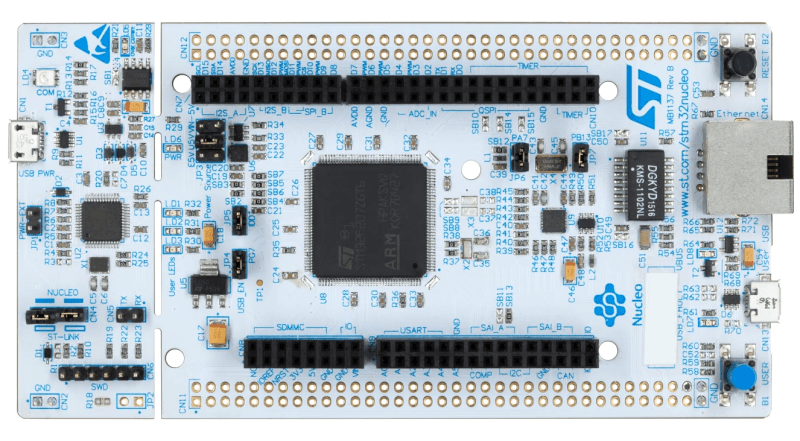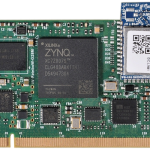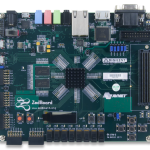Bare-metal microcontroller programming is an essential skill for those looking to dive deep into embedded systems programming. This approach involves directly interacting with the hardware of microcontrollers like the ARM-based STM32F429, found on the Nucleo-F429ZI development board. Unlike conventional programming that relies heavily on operating systems and abstracted libraries, bare-metal programming means coding with just a compiler and datasheet—giving you complete control over the microcontroller firmware. In this guide, you’ll discover all the fundamental concepts needed to embark on your bare-metal programming tutorial, starting from basic memory maps to advanced features such as timers and interrupts. Whether you’re a beginner or an experienced developer, mastering bare-metal techniques will enhance your understanding of microcontrollers and allow you to create more efficient embedded systems.
Exploring microcontroller development from a low-level perspective can significantly enhance your programming expertise. Instead of utilizing pre-packaged frameworks and libraries, bare-metal programming immerses you directly in the intricate workings of the hardware. This technique not only sheds light on the relationship between software and hardware but also empowers developers to fine-tune their applications for performance and efficiency. For instance, the STM32 programming environment often demands a meticulous approach, and the Nucleo-F429ZI guide serves as a valuable resource for this journey. By understanding how to write firmware without an operating system, you unravel the complexities of embedded systems programming and gain insights that will elevate your projects.
Introduction to Bare-Metal Microcontroller Programming
Bare-metal microcontroller programming is a pivotal topic for those working in the realm of embedded systems. This approach involves writing software that directly interfaces with the hardware without relying on an operating system. In the context of the STM32F429 microcontroller, this means engaging with various components like memory-mapped I/O, timers, and interrupts right from the start. Such an intimate level of interaction allows developers to fully understand how their code affects the hardware, leading to optimized performance and specialized features.
Many engineering professionals consider bare-metal programming challenging but rewarding. By removing layers of abstraction normally provided by operating systems and libraries, developers gain unprecedented control over hardware resources. This is essential when programming specific microcontrollers like the STM32F429ZI, where managing power, speed, and memory resources efficiently is crucial for real-time applications.
Getting Started with STM32 Programming
Before venturing into programming the STM32F429ZI, it’s vital to grasp the fundamentals highlighted in programming manuals and datasheets. Understanding the memory map and peripheral registers is foundational for effective firmware development. In STM32, peripherals such as GPIO, timers, and UART are crucial for performing operations that range from simple LED blinking to complex tasks like data communication over serial ports.
Setting up a development environment is also critical in getting started with STM32 programming. Utilizing tools such as the GNU Compiler Collection (GCC), IDEs like STM32CubeIDE, and hardware debuggers can significantly accelerate the learning curve for beginner programmers. A structured approach that combines theoretical knowledge with hands-on practice on the Nucleo-F429ZI board helps cement the concepts necessary for efficient microcontroller firmware development.
Essential Tools for Bare-Metal Programming
In bare-metal microcontroller programming, choosing the right tools can drastically improve development efficiency. The fundamental tools include a compiler, a linker, and a flasher, which together transform your code into executable form for the STM32F429 microcontroller. As you write code, the compiler translates high-level programming statements into machine code, while the linker merges various compiled files into a single binary.
Furthermore, debugging tools are indispensable for bare-metal development. Debuggers enable you to step through code, check memory values, and monitor the behavior of peripherals in real-time. Using software such as STM32CubeMX, developers can quickly configure settings for their peripherals visually, reducing the human error associated with manual configuration of registers.
Programming Techniques for Embedded Systems
Understanding various programming techniques is essential for effective embedded systems programming. Techniques such as direct register access, interrupt handling, and managing pulse-width modulation (PWM) can significantly enhance the performance and functionalities of an embedded application. For the STM32F429 microcontroller, tapping into these techniques means demonstrating true mastery over the hardware.
One common practice in embedded programming is the use of state machines to manage device states effectively. Implementing state machines allows for streamlined control of peripheral actions and event-driven programming, making code more organized and manageable. Each state can be defined explicitly, which simplifies the handling of complex tasks such as processing sensor data or managing communication protocols.
Navigating the Nucleo-F429ZI Board
The Nucleo-F429ZI board provides an excellent platform for learning bare-metal microcontroller programming. It features the STM32F429 microcontroller, which boasts advanced processing capabilities and a wide array of peripherals. Familiarizing oneself with the board layout and its pin configuration is critical for successful development, as this knowledge directly impacts how hardware components and sensors integrate with your firmware.
Utilizing the onboard interfaces, including digital and analog I/O ports, users can quickly prototype applications. For instance, the easy access to I/O pins can facilitate projects such as remote control systems or data logging devices. The Nucleo-F429ZI thus serves not only as a learning tool but also as a robust platform for real-world applications in embedded systems.
Trends in Microcontroller Firmware Development
The field of microcontroller firmware development is rapidly evolving, with trends that emphasize efficiency, security, and connectivity. As embedded systems become increasingly sophisticated, developers must be aware of the latest protocols and security measures to protect their applications. Familiarity with secure coding practices ensures that the firmware you write for devices like the STM32F429 is robust against vulnerabilities.
Moreover, with the rise of the Internet of Things (IoT), connectivity has become paramount. Implementing communication protocols such as MQTT or CoAP on bare-metal microcontrollers opens the door to a multitude of applications—from smart home devices to industrial automation solutions. Understanding how to incorporate these trends into your projects is vital to remain competitive in the ever-evolving realm of embedded systems.
Challenges Faced in Embedded Systems Programming
Embedded systems programming presents numerous challenges, particularly when working with bare environments. A notable difficulty arises from the lack of memory management features. When resources are limited, like in many STM32 projects, developers must be adept at managing memory allocation manually to prevent overflow errors or memory leaks. This involves a deep understanding of hardware resources, making precision programming imperative.
Additionally, debugging bare-metal systems can be particularly challenging due to the absence of an operating system and high-level debugging aids. Developers must rely more on their knowledge of hardware behavior and systematic testing. Techniques such as printf debugging, using in-circuit emulators, or LED indicators can often be employed to gain insights into system operation and troubleshoot effectively.
Advancing Bare-Metal Skills with Tutorials
To effectively enhance your skills in bare-metal programming, engaging with structured tutorials can be immensely beneficial. Tutorials focusing on specific platforms like the Nucleo-F429ZI not only guide users through basic tasks such as blinking LEDs but also delve into more sophisticated functionalities like setting up timers and UART communication. These hands-on experiences solidify the concepts discussed in theory and boost confidence for further experimentation.
Additionally, platforms and communities dedicated to STM32 programming can provide invaluable resources. They often feature exercises, detailed documentation, and forums for peer support. Leveraging these resources allows developers to gain insights from others’ experiences, troubleshoot issues collaboratively, and explore innovative ideas that can be applied to their projects.
The Future of Embedded Programming
The future of embedded programming lies heavily in the integration of advanced technologies such as Artificial Intelligence (AI) and Machine Learning (ML). As microcontrollers like the STM32F429 become more powerful and capable, the potential to implement intelligent algorithms directly on hardware opens up exciting possibilities for developers. This evolution necessitates programmers to expand their skill sets beyond low-level programming to incorporate higher-level abstractions and AI frameworks.
Moreover, as sustainability becomes a priority in technology development, energy-efficient programming practices are likely to be paramount. This means developers will need to focus increasingly on optimizing power consumption in their firmware, particularly for battery-operated devices in the IoT sector. The future challenges in embedded systems programming will call for innovative solutions that balance performance, resource management, and power efficiency.
Frequently Asked Questions
What is bare-metal microcontroller programming and how does it relate to STM32 programming?
Bare-metal microcontroller programming involves creating software that interacts directly with hardware without an operating system. In the context of STM32 programming, it means writing firmware for STM32 microcontrollers like the ARM-based STM32F429 that operates at a low level, directly managing hardware peripherals using a datasheet and a compiler.
How can I start with bare-metal programming on the Nucleo-F429ZI?
To begin bare-metal programming on the Nucleo-F429ZI, you should first familiarize yourself with the processor’s memory map and I/O registers. After understanding the basics, you can write a minimal firmware program to blink an LED, which is commonly used for initial projects. Following this, you can tackle more complex features like UART output or timer configuration.
What are the advantages of bare-metal embedded systems programming?
Bare-metal embedded systems programming offers greater control over the hardware and deeper insights into its operations. This approach allows programmers to optimize performance and reduce resource usage by avoiding abstraction layers provided by operating systems or middleware.
What tools are essential for bare-metal microcontroller firmware development?
Essential tools for bare-metal microcontroller firmware development include a compiler, linker, and a flasher for programming the microcontroller. Additionally, debugging tools and IDEs tailored for embedded systems can enhance development efficiency.
What topics are covered in a typical bare-metal programming tutorial for STM32?
A typical bare-metal programming tutorial for STM32 can include topics such as memory maps, I/O pin control, writing basic firmware to communicate with peripherals, managing timers, handling interrupts, and setting up a simple UART communication. Advanced tutorials may also cover embedded web server configurations.
How does bare-metal programming differ from using a bootloader in embedded systems?
Bare-metal programming refers to software that runs directly on the hardware without any abstraction, while using a bootloader involves a layer of code that initializes the hardware and loads the main application firmware. Bootloaders are convenient for firmware updates but add complexity.
Why is it important to understand the hardware specifications in bare-metal microcontroller programming?
Understanding hardware specifications is crucial in bare-metal microcontroller programming because it allows developers to effectively manipulate the hardware registers, configure peripherals accurately, and optimize the code for performance and responsiveness.
Can I use libraries in bare-metal microcontroller programming?
Bare-metal programming typically emphasizes writing code with minimal dependencies on libraries. However, occasionally light libraries or header files that do not introduce significant abstraction may be used, as long as they do not compromise the low-level control of the hardware.
What resources are available for learning bare-metal STM32 programming?
There are many resources available for learning bare-metal STM32 programming, including dedicated online courses, tutorials like Sergey Lyubka’s guide, and the STM32 Bootcamp series which provides comprehensive coverage of various aspects of programming STM32 microcontrollers.
What challenges might I face in bare-metal programming for embedded systems?
Challenges in bare-metal programming for embedded systems include debugging without advanced tools, managing limited resources, handling timing and synchronization issues, and the steep learning curve associated with direct hardware manipulation.
| Key Point | Description |
|---|---|
| Bare-Metal Programming | Programming a processor directly without an OS, using only a compiler and datasheet. |
| Target Microcontroller | Examples are focused on the Nucleo-F429ZI and its ARM-based STM32F429 microcontroller. |
| Development Approach | Involves direct manipulation of hardware and registers, bypassing high-level abstractions. |
| Getting Started | Starting with understanding memory maps and I/O pins, moving to simple firmware like blinking an LED. |
| Essential Tools | Includes a compiler, linker, and flasher, crucial for firmware development. |
| Advanced Topics | Explores timers, interrupts, UART output, debuggers, and web server configuration. |
| Learning Outcome | Greater insight and control over hardware, leading to improved embedded programming skills. |
Summary
Bare-metal microcontroller programming allows developers to gain deeper insights into hardware interactions by programming directly onto the microcontroller. This method, as outlined in Sergey Lyubka’s guide, shifts the focus from high-level abstractions to a clearer understanding of registers and memory management, particularly using tools for the STM32F429 microcontroller. The process may be time-consuming initially, but it equips programmers with essential skills and knowledge that lead to more efficient control over embedded systems.






